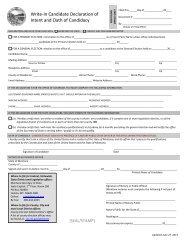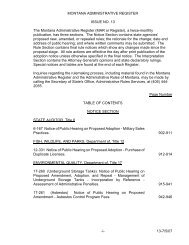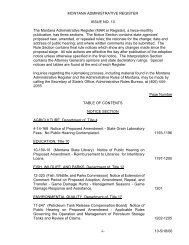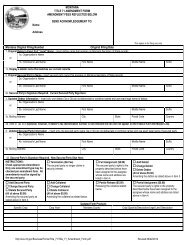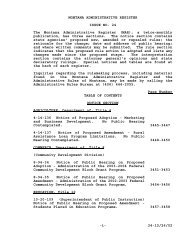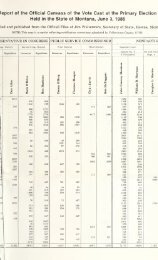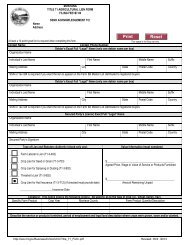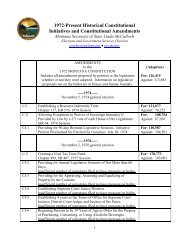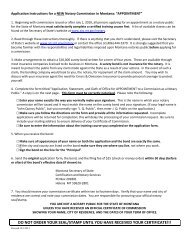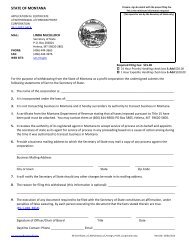Issue 3 - the Montana Secretary of State Website
Issue 3 - the Montana Secretary of State Website
Issue 3 - the Montana Secretary of State Website
You also want an ePaper? Increase the reach of your titles
YUMPU automatically turns print PDFs into web optimized ePapers that Google loves.
-370-<br />
basing design requirements on a showing that a Class II landfill unit will not<br />
contaminate <strong>the</strong> uppermost aquifer, which is <strong>the</strong> standard required by EPA in 40<br />
CFR 258.40(a)(1). Therefore, <strong>the</strong> department has eliminated (1)(b).<br />
Both existing ARM 17.50.506(2)(c) and 40 CFR 258.40(c)(3) require<br />
consideration <strong>of</strong> <strong>the</strong> volume <strong>of</strong> leachate as a component for design approval.<br />
The requirement in (3)(a), for accurate monitoring <strong>of</strong> leachate, measured to<br />
within one centimeter, is necessary for proper evaluation <strong>of</strong> <strong>the</strong> effectiveness <strong>of</strong> an<br />
approved liner. Metric units are commonly used in state rules and federal<br />
regulations, and are appropriate here.<br />
Subsection (3)(b), concerning minimum slope <strong>of</strong> a liner with a leachate<br />
collection system, is equivalent to existing rule ARM 17.50.506(6)(b). See<br />
Response to Comment No. 44. A 2% minimum slope for a leachate collection<br />
system is necessary to cause leachate to flow to <strong>the</strong> collection point. This<br />
requirement is contained in a comparable EPA guideline, Municipal Solid Waste<br />
Disposal Facility Criteria Technical Manual, Subpart D Design Criteria, EPA 530-R-<br />
93-017, page 152; and Sanitary Landfill Design and Operation, SW-65ts, page 9-35.<br />
Therefore no findings are required by 75-10-107, MCA.<br />
In response to <strong>the</strong> comment on (3)(b) concerning maximum slope for a liner,<br />
<strong>the</strong> department has stricken <strong>the</strong> requirement that <strong>the</strong> maximum slope be limited to<br />
33%. The maximum slope allowed will be determined by engineering submission<br />
and review.<br />
In response to <strong>the</strong> comment concerning (3)(c), <strong>the</strong> department has removed<br />
(3)(c) because an owner or operator is required by New Rules XXXIII and XXXIV to<br />
design a unit with an alternative liner to meet <strong>the</strong> ground water standards in Table 1<br />
<strong>of</strong> New Rule XXXIII, and to obtain department approval <strong>of</strong> that design. The<br />
department has determined that it is not appropriate to prescribe <strong>the</strong> elements <strong>of</strong><br />
that design; ra<strong>the</strong>r, it will review a design to determine whe<strong>the</strong>r it will meet <strong>the</strong><br />
standards. See Response to Comment No. 50.<br />
The purpose <strong>of</strong> (3)(d) was to require that <strong>the</strong> design <strong>of</strong> a leachate removal<br />
system, which could create a column <strong>of</strong> leachate in a pipe above a liner greater than<br />
30 cm as it was being pumped away, had to take this increased head into account<br />
to protect against leachate contamination <strong>of</strong> ground water due to stress caused by<br />
<strong>the</strong> increased head on <strong>the</strong> liner. This is a necessary element <strong>of</strong> protecting ground<br />
water at a landfill, and should be addressed in a design. This requirement is<br />
contained in existing ARM 17.50.506(8)(c). However, in response to <strong>the</strong> comment,<br />
<strong>the</strong> department is eliminating <strong>the</strong> specific requirement as unnecessary, because it<br />
must be addressed as part <strong>of</strong> <strong>the</strong> design <strong>of</strong> <strong>the</strong> unit to show that ground water will<br />
not be contaminated at <strong>the</strong> RPOC.<br />
Concerning (6), CQA and CQC plans are necessary to ensure a landfill was<br />
correctly constructed, and it is necessary for <strong>the</strong> department to review <strong>the</strong>m to<br />
determine whe<strong>the</strong>r <strong>the</strong>y are adequate. Use <strong>of</strong> CQA and CQC plans is contained in<br />
comparable EPA guidelines and <strong>the</strong> scientific literature. See, Quality Assurance<br />
and Quality Control for Waste Containment Facilities, EPA/600/R-93/182, page 11,<br />
which was expanded into a book by D.E. Daniel, Ph.D, P.E., and R.M. Koerner<br />
Ph.D, P.E., entitled Waste Containment Facilities- Guidance for CQA and CQC <strong>of</strong><br />
Liner and Cover Systems (American Society <strong>of</strong> Civil Engineers 2d ed. 2007).<br />
Research conducted by <strong>the</strong> Solid Waste Association <strong>of</strong> North America (SWANA)<br />
<strong>Montana</strong> Administrative Register 3-2/11/10



